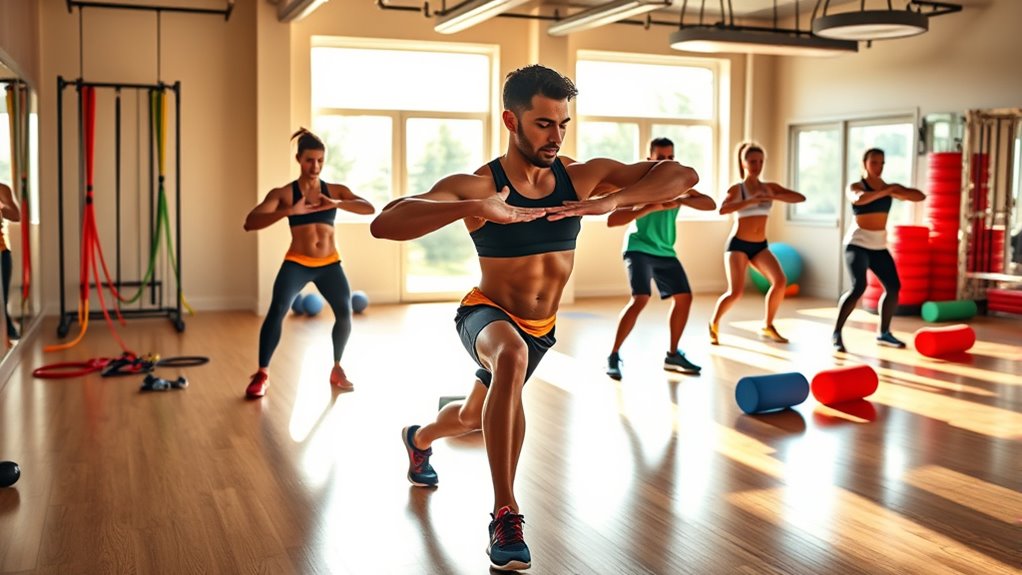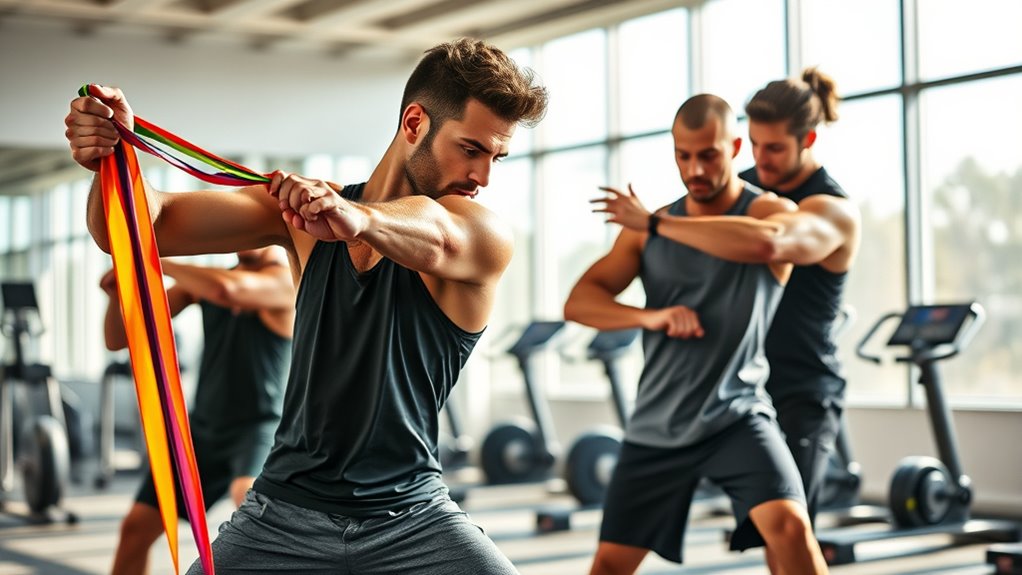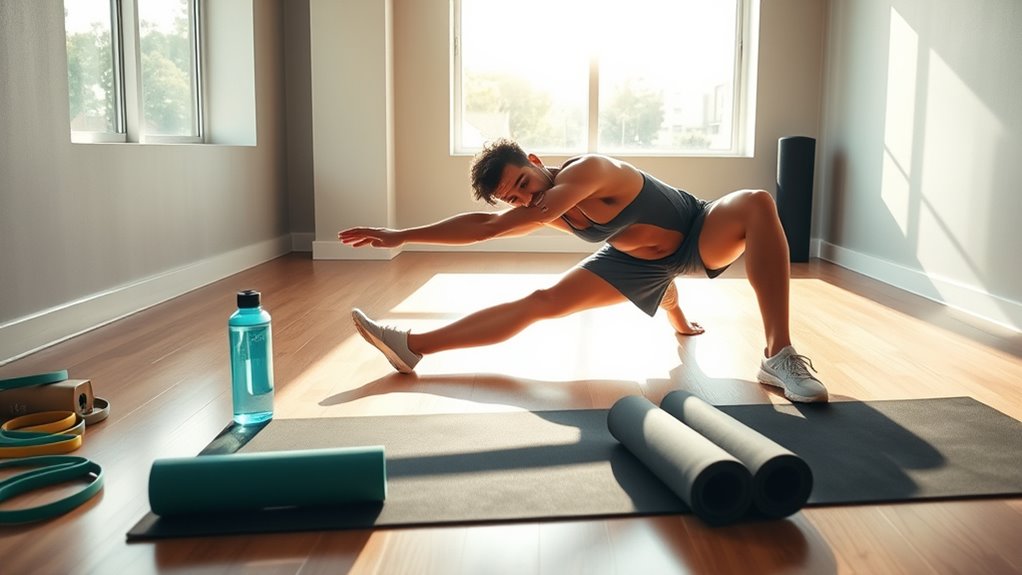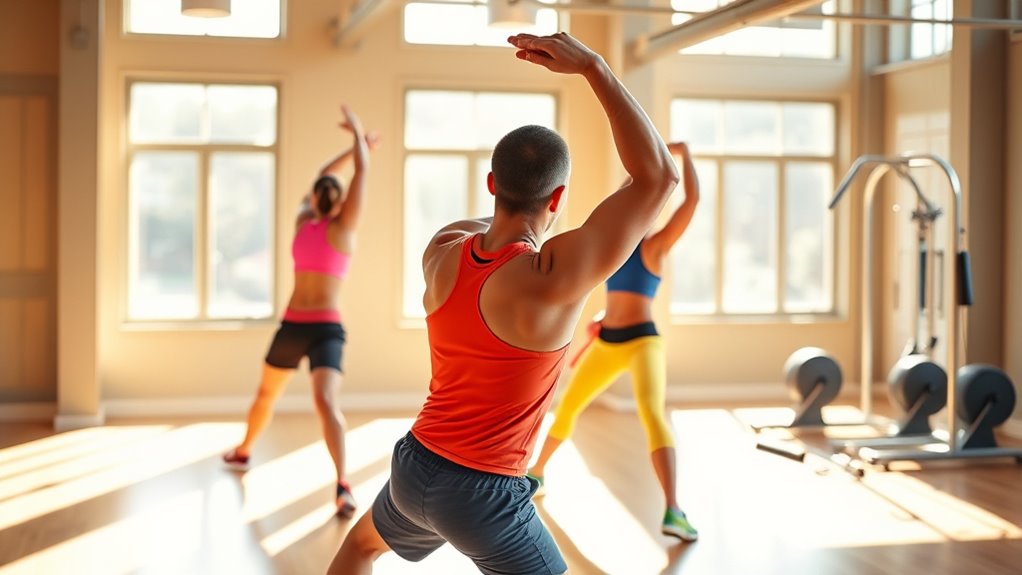Top pros swear by dynamic warm-up routines that include active movements like leg swings and arm circles, which boost blood flow and activate key muscles. They focus on mimicking workout motions to prepare their nervous system and improve flexibility. Crafting your own routine by tailoring exercises to your activity and fitness level can boost performance and reduce injuries. Keep exploring to discover more tips on customizing your warm-up for ideal results and safety.
Key Takeaways
- Elite athletes use dynamic stretching and movement-specific drills to increase blood flow and activate muscles effectively.
- Proper warm-up routines optimize neuromuscular coordination, enhancing performance and reducing injury risk.
- Customizing warm-ups based on activity type and fitness level ensures better muscle readiness.
- Incorporating muscle activation exercises prepares key muscle groups for high-intensity efforts.
- Consistent, scientifically supported warm-up routines boost overall exercise efficiency and safety.
The Science Behind Effective Warm-Ups

Understanding the science behind effective warm-ups helps you prepare your body properly for physical activity. When you incorporate dynamic stretching, you’re actively moving muscles through their full range of motion, increasing blood flow and warming your tissues. This process promotes muscle activation, making your muscles more responsive and reducing injury risk. Dynamic stretches, like leg swings or arm circles, mimic the movements you’ll perform during your workout, helping your nervous system adapt quickly. By engaging in these movements, you improve flexibility and prepare your muscles for higher intensity efforts. This scientifically backed approach boosts your performance and minimizes the chances of strains or pulls. Additionally, focusing on proper refresh rates during warm-ups can help your eyes and neuromuscular system coordinate better, enhancing overall exercise efficiency. Ultimately, understanding these mechanisms encourages you to adopt warm-up routines that optimize readiness and safety before exercise.
Key Exercises Used by Elite Athletes

Elite athletes incorporate a variety of key exercises into their warm-up routines to enhance performance and prevent injuries. Dynamic stretches are vital, involving movements like leg swings or arm circles that increase blood flow and improve flexibility. These exercises prepare your muscles for the upcoming activity by mimicking the movements you’ll perform, making them highly effective. Muscle activation drills also play an essential role; exercises like glute bridges or band walks target specific muscles to guarantee they’re ready to perform at their best. Incorporating these exercises helps elevate your core temperature and activate key muscle groups, reducing injury risk. Employing a methodical approach to warm-up routines ensures consistency and effectiveness. By focusing on dynamic stretches and muscle activation, you set a solid foundation for a successful workout or competition.
Tips for Crafting Your Personalized Warm-Up Routine

Creating a personalized warm-up routine begins with evaluating your specific activity and fitness level. Focus on incorporating dynamic stretching to increase blood flow and improve range of motion relevant to your workout. This prepares your muscles for movement and helps prevent injury. Equally important is mental preparedness; take a moment to focus your mind, set intentions, and visualize your performance. Tailor your warm-up to match the intensity and duration of your activity, ensuring it’s neither too brief nor overly exhausting. Include movements that mimic your main workout, gradually increasing in intensity. Regularly reassess and adjust your routine based on how your body responds. Incorporating specific dog breeds into your warm-up can also enhance your motivation and enjoyment of exercise. With a thoughtful approach, your warm-up will boost both physical readiness and mental focus, setting you up for success.
Frequently Asked Questions
How Long Should a Warm-Up Last for Optimal Benefits?
For ideal benefits, you should warm up for about 10 to 15 minutes. Focus on dynamic stretching to increase blood flow and loosen muscles, and don’t forget mental preparation to get your mind ready for activity. Keep it active and engaging, so your body is prepared without overdoing it. This balanced approach helps prevent injuries and boosts performance, making your workout more effective and enjoyable.
Can Warm-Ups Prevent All Types of Sports Injuries?
Did you know that proper warm-ups can reduce injury risk by up to 50%? While warm-ups, including dynamic stretching, markedly lower the chance of injuries, they can’t prevent all types. They also boost mental preparedness, helping you stay focused. However, some injuries stem from overuse or accidents, which warm-ups alone can’t prevent. So, stay consistent with your routines and listen to your body for best protection.
Are There Warm-Up Routines Suitable for Older Adults?
Yes, there are warm-up routines suitable for older adults. You should focus on age-appropriate exercises that incorporate gentle mobility movements. These routines help improve flexibility, circulation, and reduce injury risk without overexerting you. By gradually preparing your muscles and joints, you can enjoy physical activity safely. Always listen to your body and consult a professional if you’re unsure about specific exercises.
How Often Should I Update My Warm-Up Routine?
Think of your warm-up as a playlist that keeps your workout fresh. You should update it every few months to incorporate new dynamic stretching moves and improve mental preparation. Just like a playlist evolves with your tastes, your routine benefits from change to prevent plateaus and keep you engaged. Regular updates ensure you stay flexible, focused, and ready to perform at your best.
Is Stretching Necessary During Every Warm-Up?
You might wonder if stretching is necessary every warm-up. Incorporate dynamic stretching to activate your muscles and improve flexibility, which is vital before activity. Static stretching, on the other hand, is better after your workout to cool down. Including both types in your routine can prevent injuries and boost performance. So, yes, stretching plays an essential role, but focus on dynamic before activity and static afterward for best results.
Conclusion
A well-crafted warm-up can boost your performance and reduce injury risk. Did you know that athletes who warm up properly improve their speed and strength by up to 20%? By incorporating science-backed exercises and tailoring your routine, you set yourself up for success. Remember, consistency is key—making warm-ups a habit can transform your workout results and keep you safe. So, get moving and warm up like the pros!









